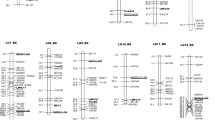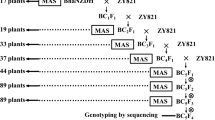Abstract
Genetical maps of molecular markers in two very different F1-derived doubled-haploid populations of Brassica oleracea are compared and the first integrated map described. The F1 crosses were: Chinese kale×calabrese (var. alboglabra×var. italica) and cauliflower×Brussels sprout (var. botrytis×var. gemmifera). Integration of the two component maps using Joinmap v.2.0 was based on 105 common loci including RFLPs, AFLPs and microsatellites. This provided an effective method of producing a high-density consensus linkage map of the B. oleracea genome. Based on 547 markers mapping to nine linkage groups, the integrated map covers a total map length of 893 cM, with an average locus interval of 2.6 cM. Comparisons back to the component linkage maps revealed similar sequences of common markers, although significant differences in recombination frequency were observed between some pairs of homologous markers. Map integration resulted in an increased locus density and effective population size, providing a stronger framework for subsequent physical mapping and for precision mapping of QTLs using substitution lines.
Similar content being viewed by others
Author information
Authors and Affiliations
Additional information
Received: 5 February 1999 / Accepted: 16 June 1999
Rights and permissions
About this article
Cite this article
Sebastian, R., Howell, E., King, G. et al. An integrated AFLP and RFLP Brassica oleracea linkage map from two morphologically distinct doubled-haploid mapping populations. Theor Appl Genet 100, 75–81 (2000). https://doi.org/10.1007/s001220050011
Issue Date:
DOI: https://doi.org/10.1007/s001220050011




